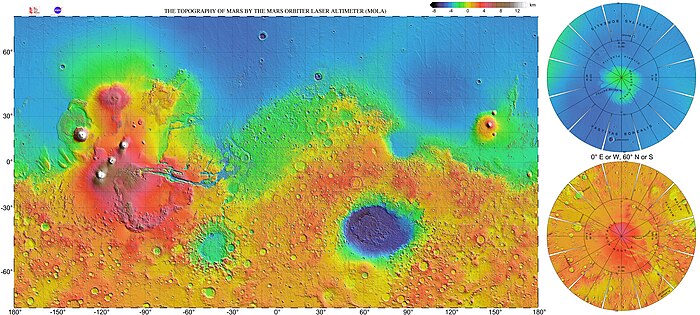
Against giants such as Jupiter, what records can Mars hold?
Our closest neighbour has remained a piece of intrigue to those of us on Earth for as long as it has been observed. Since its discovery by curious star-gazers belonging to ancient civilizations, Mars has fascinated our human population.
A relatively small, dusty, red rock, one could be forgiven for thinking that, apart from the striking red colour, this was a somewhat uninteresting and insignificant planet. Certainly not one that could hold record titles against other planets in the solar system. Well, this isn’t the case, there are in fact a number of record titles that Mars holds — titles which it looks to be holding onto for some time to come.
Record Number 1: The Largest Canyon in the Solar System – Valles Marineris

Named for the satellite that discovered this area of Mars, Mariner 9, back in 1972, Valles Marineris is a vast canyon system that creeps and crawls through a region known as the Tharsis area. The canyons run along the surface of the red planet for over 4000km. They are over 200km wide in some places and up to 7km deep. Valles Marineris is, by volume, the largest in the solar system and is only just beaten in length by Earth’s own rift valleys.
If you’re looking for a straight forward comparison, think about the Grand Canyon in the US. The Grand Canyon is a mere 800km long and up to 1.6km deep. Valles Marineris is over 5 times as long and almost 4 times as deep in places! Much like the large canyons of Earth, researchers believe that Valles Marineris was created through extended periods of tectonic activity under the Martian surface.
Record Number 2: The Largest Volcano in the Solar System – Olympus Mons

Olympus Mons. Even the name sounds grand and imposing. Named after the Latin for Mount Olympus, the mythical seat of the Ancient Greek gods and home to Zeus, god of thunder, king of gods. Once more, sounds grand and imposing. And frankly, that’s rightly so.
Olympus Mons is the largest volcano in our solar system — and not by a little, but by a whole lot. After measurements were taken by the Mars Orbiter Laser Altimeter (MOLA), Olympus Mons was measured to be nearly 22km tall. That makes it around 2.5 times larger than Mount Everest when measured from sea level. The volcano takes the titles largest volcano and tallest planetary mountain but just misses out on the tallest mountain in the solar system by a bit of a loophole from Vesta.
You’d be forgiven for wondering what Vesta is. It’s one of the largest asteroids in the asteroid belt and has claim to the largest mountain, pipping Olympus Mons by only hundreds of metres. This mountain, however, was formed following a massive impact and is part of the Rheasilvia crater. Does that count? Well… just.
Record Number 3: The Largest Impact Crater in the Solar System – North Polar Basin

This record isn’t going to get such a good write up as technically it might not even be correct. The North Polar Basin has been hypothesised as an impact crater, and if classified as such would have a ratio of between 125-155% of the planet’s surface with a crater diameter of 10,600 × 8,500 km. But, this has not been recognized as fact by the IAU (International Astronomical Union).
Should it not be deemed an impact crater then this record will be passed to the previously mentioned Rheasilvia crater with a diameter of 505 km but a ratio of 90%.
Mars: The Record Breaker
As humankind begins to explore Mars further who knows which records it might gain or take mantle of in the future. Could it hold the largest known water reserves? The most minuscule life forms? Time will tell!
